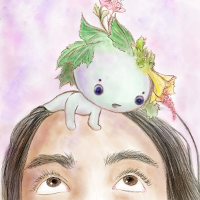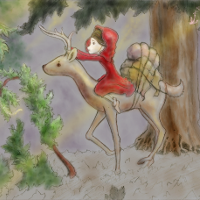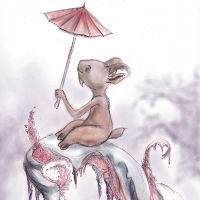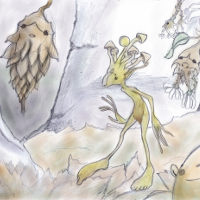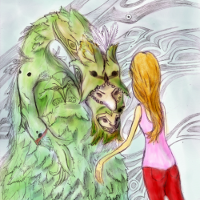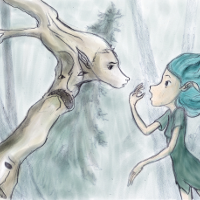 |
Information and stories on Japanese Gods
.
 |
|
Fairy Tales Home Fairies Celtic Fairies Fairy Blog Finno-Baltic-Siberian Fairies Slavic Fairies
|
Japanese Fairy tales Oni Tengu Kitsune Tanuki  Kami Japanese Folk Tales With Kami Introduction to Japanese Kami Mountain Kami Taming the Kami of the Earth Folk Beliefs Folk Tales with Kami in them. The Bear Gaurdian An old man helps a bear which upon their death turns into the Kami of a stone and gaurds a village. There are many tales in Japan which speak of Kami that were once an animal, who's spirit came to reside in a tree or a rock. In one village a man builds a shrine to pacify the spirit of a cow which had been killed. The Kami which came from this was said to have a special ability to cure skin ailments. Prince Jaschima and the Fox A prince battles two men to rescue a fox. Cat Guardian A cat battles a magical rat to protect a merchants daughter. The Greatful Fox A man buys a fox's freedom and is repaid with a sacrifice from the fox when he grows ill. Koremotschi and the Oni A samurai goes out hunting and an Oni lays a trap for him. Sword of the Fox Japan needs a magical sword to find victory over Korea and so a white fox is sent by the Kami to aid in its creation. The Snakes Revenge A man kills a snake who's spirit gets revenge The Priest and the Kami's Cave A man enters a secret and sacred cave, but overwhelmed with pride at this he gets into trouble. Schojoo A river kami who loves saki and will give everlating jugs of sake to kind hearted people. The Thunder Kami An old man and his granddaughter seek out a thunder kami to make it rain so they don't loose their crops. Envy Brings Suffering A poor good man has a dog which brings him many treasures. A greedy old man kidnaps the dog. The Mountain Kami and the Ugly Fish A mountain kami sees his reflection in the water and runs off in shame at what he sees. The Hung Up Money Tree A woman goes climbing up a mountain to pray for her banished husband, but a man tries to trick her so she hangs money on the wrong tree. The man tries to steal it so the Kami turn the tree into a giant snake. Kami of the Green Growing Things How the Kami of the Green Growing Things came to be honored in Japan. The Princess Moonbeam A poor woman prays to the mountain for a child. The Single Lantern of Yamato The offering of one poor woman is worth more then the large offerings of the rich. The Soul of the Samurai A samurai makes a great sacrifice to appease the kami The Princess of the Sea The story of a sea princess who falls in love with the world of the shore The Waterfall Which Flowed Sake The Boy and the Spirit of Things The Goblin Tree The Man Who Became a Serpant Introduction to Japanese Kami By some definitions Kami are the Japanese Gods, the gods of Shintoism, however, the word Kami is much more complex than that. Kami is a complex term, one which is often translated into English as spirit, god or occasionally fairy. In truth all of these terms may fit sometimes but none of them fits all the time. A long time ago the term Fairies might have fit the best given the original place of fairies in European mythology but in modern lore the term fairy has changed so much that most people who have not studied fairies extensively do not know what the word means. The best definitions for Kami are perhaps "A kami is any thing or phenomenon that produces the emotions of fear and awe, with no distinction between good and evil." and or those things which are worth praying to in the Shinto conception of the world. Finally Ashkenazi states that; "the term (kami) functions as both a noun and an adjective. As a noun, Kami means a powerful being with an interest in the lives of humans and the ability to invervene in human affairs, either directly or indirectly, by influencing the activities of other kami, animals, or natural events and features.... As an adjective, the term means something colse to 'holy': a mysterious and elveating quality that various living beings, including animals nd humans posess to varying degrees." Kami then is not necessarily a designation of physical power so much as its a statement that something is worth praying to such that if one needs their radishes to grow larger then one doesn't need to make a major offering to a heavenly Kami, instead one can request aid from a smaller local Kami. Thus Kami lie on a continuum from heavenly Kami which rule over major phenomenon such as the Sun, the Wind and Underworld, etc. to minor Kami which live within rocks, trees, etc and may not be very powerful but which can bring luck, help crops grow, aid in studying for a test, etc. Many of the Kami are in fact not necessarily physically stronger then humans; in legend a farmer threatened to beat a thunder Kami if it didn't grant his wish to have strong children, a child saved the daugher of a Dragon King from a group of other children, people may go and cut down the trees which kami live in. Ultimatly then as with fairies kami lie on a plane which seems to be much more level with humanity. In some ways this makes sense mythologically speaking given that many humans were believed to be related to the Kami in certain ways. Though these humans themselves weren't typically Kami (except for the Emporer of Japan and a few other people as well as the spirits of some of some people which had died). The truth is that it must be accepted that as a religious being Kami are beyond our understanding, they are rather an synthisis of ideas which may seem controdictory. Rather to understand the nature of Kami one must study Kami to try to grasp the complexity of the term. First Kami as previously mentioned is a concept related to being awe inspiring and worth praying to. It is also a designation which typically implies some level of sacred/purity though kami themselves can do impure things so kami is not a garantee of purity. Althoughy there are many types of Kami a few of interest are; Heavenly Kami: Kami which come from and typically continue to live in the heavens, these Kami are can be equated to the Greek idea of deity to some extent. Kami of Natural Phenomenon These Kami live within mountains trees, cause the thunder, etc. To some extent or another nearly everything has a spirit within it, but not all of these spirits are necessarily kami. Kami of Abstact ideas and Goals These include Kami of Education, Kami of Fertility, etc. Human souls which have become Kami after they died, Sugawara no Michizane for example became Tenjin, a Kami of Scholarship. Ancestrial spirits in general can be considered Kami to some extent as well. Along with these basic designations there are also levels of Kami, further each kami has four souls and three natures. Their natures are; Aramitama, Nigimitama, and Sakimitama - any one of these natures can become dominant thus completely changing the way the Kami acts, what they desire, and what goals they will have. The Aramitama is violent and generally destructive. However, it is important to keep in mind that destructiveness is not always harmful. After all, it was violence and destructiveness that saved Japan from the genocide of the Mongols and protected people from other dangers. The second type, Nigimitama, is the gentle functional nature which Kami uses to make the crops grow and the water pure. However, Kami in this state do not go out of their way to do good. They simply keep the natural order of things so that there is enough for humans and animals to survive. Kami which have entered the state of Aramitama need to be calmed and returned to the state of Nigimitama through active worship. This means not only are there many kami each with their own personality but each Kami has various souls which can manifest at different times. |
|
